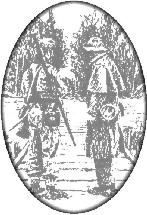
Women in Uniform
In the last few years, historians have become more and more aware of what was previously thought to be a limited phenomenon in the Civil War: the incidence of women disguising themselves as men and enlisting in the army, for any number of reasons.
There were numerous women openly serving with the armies on both sides, but recognized as female; the Union forces, more so than the Confederates, had in their ranks vivandieres, women who marched alongside the men, often going into battle with them, to provide medical assistance, carry water and ammunition down the line, and to carry messages between troops and their commanders. In addition, women such as Captain Sally Tompkins, who ran a hospital in Richmond for the Confederacy and was rewarded with a salaried rank in the Southern army, and Bridget Divers, who served openly in her husband's company of the First Michigan Cavalry, were tireless fighters in their own ways for the aims of their nations and flags.
But as time goes by, more stories are coming to the surface of women who left home disguised as men and passed through the haphazard enlistment process without being detected for what they really were. With few exceptions, these women served gallantly for all or part of the war; some of them, revealed to be women when they fell ill or were wounded, were either honorably discharged or summarily dismissed, depending on the mood of whatever general caught them or had to deal with them. Some of them even drew veterans' pensions in the years following the war.
Their reasons for serving were as different and varied as the women themselves. Sarah Emma Edmonds, a young Canadian girl, ran away from home to avoid an arranged marriage; she impersonated a male bookseller in the United States for a time, then enlisted in the Union army as Frank Thompson. She served with the Second Michigan Infantry until a bout of malaria made her fear she would be caught in her masquerade; she deserted, but was legally cleared of that desertion long after she had been married and had become a mother.
Jennie Hodgers, who stowed away on a ship leaving Ireland bound for the United States in 1844, disguised herself as one Albert D. J. Cashier and served in the Illinois Volunteer Infantry from 1862 until the end of the war. She was never suspected to be anything more than likeable, shy, and very brave. Her masquerade was only discovered long after the war, when at the age of 66 she broke her leg in an automobile accident-and the doctor at the veteran's hospital found her out. The secret was kept, however, and she successfully drew the veteran's pension she was entitled to for her gallant service.
There were others, of course, known and unknown, but one of the women passing for men in the armed forces who seems to have not only served well, but had a good time doing so, was Loreta jancta Velazquez of the Arkansas Grays, an infantry unit she raised and equipped at her own expense. Velazquez was the Cuban-born widow of a Confederate soldier who died of an accidental gunshot injury early in the war; she left her New Orleans home in search of adventure, with the romantic notion of becoming a "second Joan of Arc." She created a system of wire shields and braces to hide her breasts, put on a Confederate uniform, and adopted the name Harry Buford. She then traveled to Arkansas, where she would presumably not be recognized, and recruited for her new command.
She was elected lieutenant, and her career as the commander of the Grays began at First Manassas (First Bull Run). Eventually she ended up serving with the army in Kentucky and Tennessee, during which service she was twice wounded and cited for gallantry. She did not seem to care for the private behavior of men, finding that when they were reasonably sure there were no women around, their conversation became disgusting and full of "thoroughly despicable" comments about women.
She wound up in Richmond, where someone figured out she was a woman herself. Temporarily arrested as a possible spy, she convinced Confederate authorities that she was a loyal citizen and embarked on a career as a secret agent for the South. Her operations took her to Canada and to the Federal capital at Washington, D. C. Her postwar narrative account of her adventures, amusing, harrowing, and very well written, contains a comment that might well serve as an epitaph for all the women, known and unknown, who chose this unique and dangerous way to serve their country: "Notwithstanding the fact that I was a woman, I was as good a soldier as any man around me, and as willing as any to fight valiantly and to the bitter end before yielding."
Source: The Civil War Society's "Encyclopedia of the Civil War"
Move directly to:
Dyro's Civil War Home Page
Dyro's Home Page
Last Modified: July, 2005